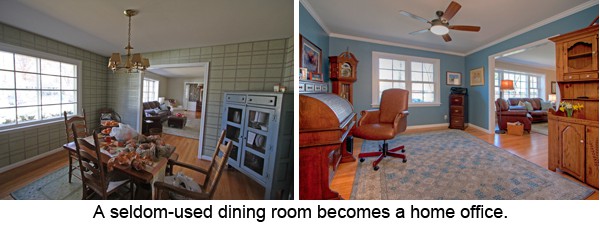DESIGNER TALK Do You Really Need a Dining Room?
 Karen Bruns, Mosby Building Arts Designer
Karen Bruns, Mosby Building Arts Designer
In the remodeling world, we continually confront this question: Dining rooms – do we really need them anymore?
Dining rooms have been a mainstay of the American home forever. But at some point in our recent history, we’ve stopped using them with any frequency. How did the dining room become an uninhabited island?
Our lifestyles have radically changed from the traditional notion of a family gathering at a set time in the evening to eat a meal together. It has become easier to do grab-and-go meals, or stay in the kitchen to eat and chat with whomever is around. There’s just no need to go into the dining room on a daily basis.
Formal entertaining at home is giving way to eating out with friends. People eat out far more now than they did 20 or 30 years ago. When they do entertain at home, they congregate in the kitchen and casual living spaces open to the kitchen.
The dining room has become a victim of its isolation and formality. Even its placement in older homes creates a barrier from the kitchen, and when it opens onto a seldom-used front living room, it’s double dinosaur extinction!
The remaining purpose of a traditional dining room is as a place to host large, infrequent gatherings of family and friends, typically at the holidays. How does one expand the dining room’s life beyond Thanksgiving dinner?
Making it a shared-use room is one option. Pair a dining room with an office or library. Built-ins can house a combination of dinnerware and bookcases. A large dining table can become a good desk and work surface. Dining chairs that are only needed for a large dinner can be placed in nearby areas for more frequent use, such as a pair of dining chairs creating a conversation area in an empty corner of a great room, or in a foyer.
In a recent project I converted a small, isolated dining room into a full time office, where quiet isolation was a benefit. The dining table moved to the old living room, which was next to the family room. I removed the wall between living and family rooms creating one big space. Diners can share the warmth of the family room fire, and the dining space adds elbow room when the family room has overflow capacity. All of this space opens to the kitchen so no one is isolated. Flexibility in function is the key ingredient.
Just as our lifestyles have changed, so must our thinking of what to do with a dining room. It’s valuable square footage that should not go to waste. If you’d like to find a new solution for your St. Louis dining room, I’d love to help. Give me a call at the Mosby Building Arts office (314.909.1800) or contact me here.





